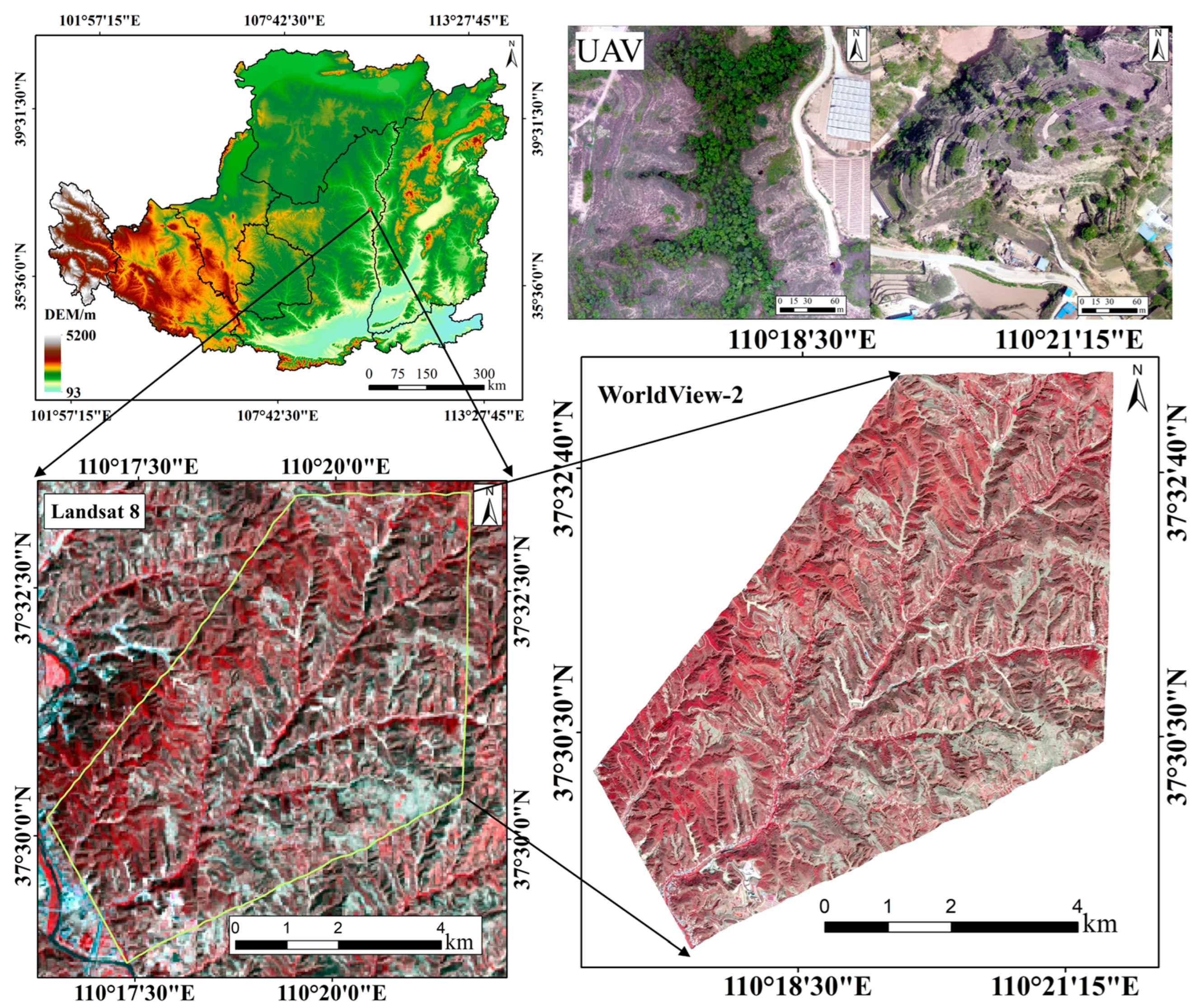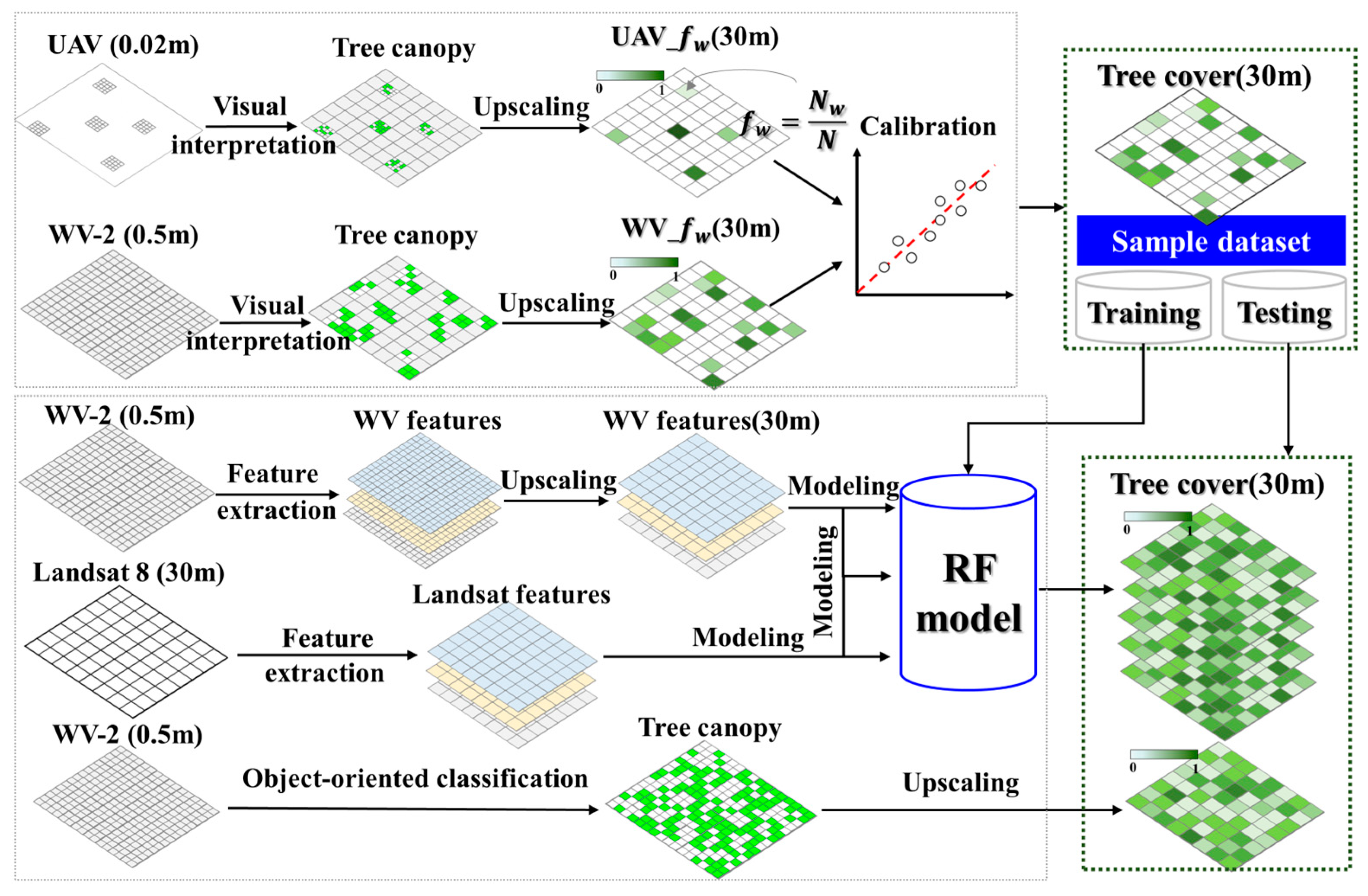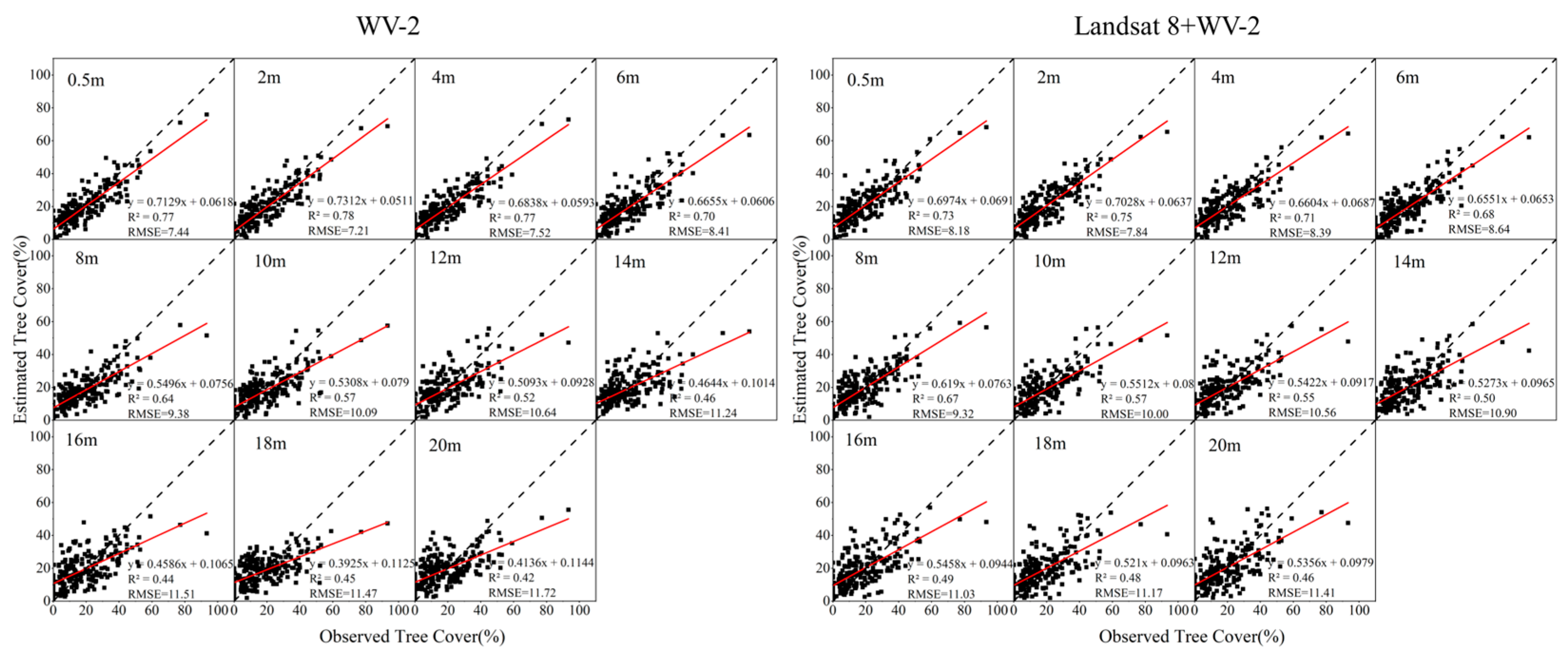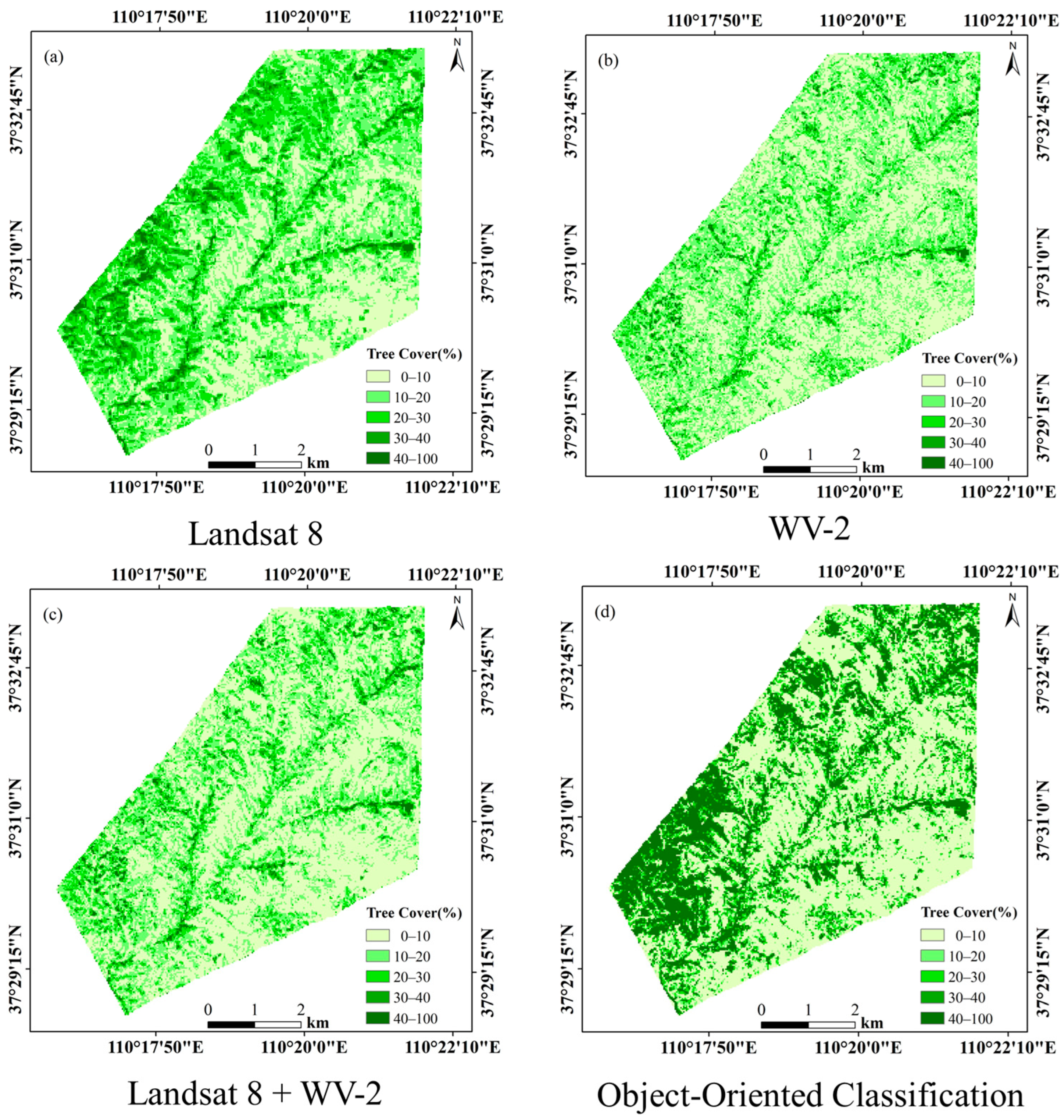Improving Tree Cover Estimation for Sparse Trees Mixed with Herbaceous Vegetation in Drylands Using Texture Features of High-Resolution Imagery
Abstract
1. Introduction
2. Study Area and Data
2.1. Study Area
2.2. Multiscale Remote Sensing Observation
2.2.1. Landsat 8 Imagery
2.2.2. WorldView-2 High-Resolution Imagery
2.2.3. Unmanned Aerial Vehicle (UAV) Imagery
2.2.4. Tree Cover Products
2.3. Sample Dataset
2.3.1. Creating a Sample Dataset of Tree Types
2.3.2. Creation of Tree Coverage Sample Dataset
3. Methods
3.1. Overall Methodology
3.2. Tree Cover Derived from WV-2 Classification Map
3.3. Tree Cover Estimation Using Different Remote Sensing Features
3.3.1. Random Forest Model
3.3.2. Image-Derived Predictor Variables
3.3.3. Optimum Remote Sensing Features Selection
3.4. Accuracy Validation
4. Results
4.1. Recursive Feature Elimination (RFE)
4.2. Validation Comparison between Model Accuracy Based on Different Methods
4.3. Comparison of Model Accuracy Verification Based on Texture Features at Different Resolutions
4.4. Tree Cover Mapping
5. Discussion
5.1. Implication of High-Resolution Imagery on Estimating Tree Cover
5.2. Comparison with Existing Tree Cover Products
5.3. Uncertainty
5.4. Applicability and Limitations to Other Geographical Regions
6. Conclusions
Author Contributions
Funding
Data Availability Statement
Acknowledgments
Conflicts of Interest
Appendix A
| Landsat 8 | WV-2 | ||
|---|---|---|---|
| Blue, Green, Red, NIR, SWIR1, SWIR2 | Blue, Green, Red, NIR | ||
| TIRS1, TIRS2 | NDVI | VDVI | |
| NDMI | NDVI | Blue M GLCM Mean | Blue M GLCM Variance |
| RVI | EVI | Blue M GLCM Homogeneity | Blue M GLCM Contrast |
| GRVI | NIRv | Blue M GLCM Dissimilarity | Blue M GLCM Entropy |
| DVI | GNDVI | Blue M GLCM ASM | Blue M GLCM Correlation |
| MSAVI | Green M GLCM Mean | Green M GLCM Variance | |
| Blue GLCM Mean | Blue GLCM Variance | Green M GLCM Homogeneity | Green M GLCM Contrast |
| Blue GLCM Homogeneity | Blue GLCM Contrast | Green M GLCM Dissimilarity | Green M GLCM Entropy |
| Blue GLCM Dissimilarity | Blue GLCM Entropy | Green M GLCM ASM | Green M GLCM Correlation |
| Blue GLCM ASM | Blue GLCM Correlation | Red M GLCM Mean | Red M GLCM Variance |
| Green GLCM Mean | Green GLCM Variance | Red M GLCM Homogeneity | Red M GLCM Contrast |
| Green GLCM Homogeneity | Green GLCM Contrast | Red M GLCM Dissimilarity | Red M GLCM Entropy |
| Green GLCM Dissimilarity | Green GLCM Entropy | Red M GLCM ASM | Red M GLCM Correlation |
| Green GLCM ASM | Green GLCM Correlation | NIR M GLCM Mean | NIR M GLCM Variance |
| Red GLCM Mean | Red GLCM Variance | NIR M GLCM Homogeneity | NIR M GLCM Contrast |
| Red GLCM Homogeneity | Red GLCM Contrast | NIR M GLCM Dissimilarity | NIR M GLCM Entropy |
| Red GLCM Dissimilarity | Red GLCM Entropy | NIR M GLCM ASM | NIR M GLCM Correlation |
| Red GLCM ASM | Red GLCM Correlation | Blue SD GLCM Mean | Blue SD GLCM Variance |
| NIR GLCM Mean | NIR GLCM Variance | Blue SD GLCM Homogeneity | Blue SD GLCM Contrast |
| NIR GLCM Homogeneity | NIR GLCM Contrast | Blue SD GLCM Dissimilarity | Blue SD GLCM Entropy |
| NIR GLCM Dissimilarity | NIR GLCM Entropy | Blue SD GLCM ASM | Blue SD GLCM Correlation |
| NIR GLCM ASM | NIR GLCM Correlation | Green SD GLCM Mean | Green SD GLCM Variance |
| SWIR1 GLCM Mean | SWIR1 GLCM Variance | Green SD GLCM Homogeneity | Green SD GLCM Contrast |
| SWIR1 GLCM Homogeneity | SWIR1 GLCM Contrast | Green SD GLCM Dissimilarity | Green SD GLCM Entropy |
| SWIR1 GLCM Dissimilarity | SWIR1 GLCM Entropy | Green SD GLCM ASM | Green SD GLCM Correlation |
| SWIR1 GLCM ASM | SWIR1 GLCM Correlation | Red SD GLCM Mean | Red SD GLCM Variance |
| SWIR2 GLCM Mean | SWIR2 GLCM Variance | Red SD GLCM Homogeneity | Red SD GLCM Contrast |
| SWIR2 GLCM Homogeneity | SWIR2 GLCM Contrast | Red SD GLCM Dissimilarity | Red SD GLCM Entropy |
| SWIR2 GLCM Dissimilarity | SWIR2 GLCM Entropy | Red SD GLCM ASM | Red SD GLCM Correlation |
| SWIR2 GLCM ASM | SWIR2 GLCM Correlation | NIR SD GLCM Mean | NIR SD GLCM Variance |
| NIR SD GLCM Homogeneity | NIR SD GLCM Contrast | ||
| NIR SD GLCM Dissimilarity | NIR SD GLCM Entropy | ||
| NIR SD GLCM ASM | NIR SD GLCM Correlation | ||
References
- Deng, N.; Wang, H.; Hu, S.; Jiao, J. Effects of afforestation restoration on soil potential N2O emission and denitrifying bacteria after farmland abandonment in the Chinese loess plateau. Front. Microbiol. 2019, 10, 262. [Google Scholar] [CrossRef] [PubMed]
- Lan, X.; Liu, Z.; Yang, T.; Cheng, L.; Wang, X.; Wei, W.; Ge, Y.; Chen, X.; Lin, L.; Zhao, T.; et al. Land-Use Intensity Reversed the Role of Cropland in Ecological Restoration Over the World’s Most Severe Soil Erosion Region. Earth’s Future 2023, 11, e2022EF003388. [Google Scholar]
- Huang, W.; Wang, P.; He, L.; Liu, B. Improvement of water yield and net primary productivity ecosystem services in the Loess Plateau of China since the “Grain for Green” project. Ecol. Indic. 2023, 154, 110707. [Google Scholar] [CrossRef]
- Zhan, T.; Zhao, W.; Feng, S.; Hua, T. Plant community traits respond to grazing exclusion duration in alpine meadow and alpine steppe on the Tibetan plateau. Front. Plant Sci. 2022, 13, 863246. [Google Scholar] [CrossRef] [PubMed]
- Liu, Y.; Ge, J.; Guo, W.; Cao, Y.; Chen, C.; Luo, X.; Yang, L.; Wang, S. Revisiting biophysical impacts of greening on precipitation over the Loess Plateau of China using WRF with water vapor tracers. Geophys. Res. Lett. 2023, 50, e2023GL102809. [Google Scholar] [CrossRef]
- Zhang, X.; Liao, C.; Li, J.; Sun, Q. Fractional vegetation cover estimation in arid and semi-arid environments using HJ-1 satellite hyperspectral data. Int. J. Appl. Earth Obs. Geoinf. 2013, 21, 506–512. [Google Scholar] [CrossRef]
- Jia, K.; Liang, S.; Liu, S.; Li, Y.; Xiao, Z.; Yao, Y.; Jiang, B.; Zhao, X.; Wang, X.; Xu, S.; et al. Global land surface fractional vegetation cover estimation using general regression neural networks from MODIS surface reflectance. IEEE Trans. Geosci. Remote Sens. 2015, 53, 4787–4796. [Google Scholar] [CrossRef]
- Song, D.X.; Wang, Z.; He, T.; Wang, H.; Liang, S. Estimation and validation of 30 m fractional vegetation cover over China through integrated use of Landsat 8 and Gaofen 2 data. Sci. Remote Sens. 2022, 6, 100058. [Google Scholar] [CrossRef]
- Wen, Z.; Brian, G.L.; Jiao, F.; Lei, W.; Shi, H. Stratified vegetation cover index: A new way to assess vegetation impact on soil erosion. Catena 2010, 83, 87–93. [Google Scholar]
- Chen, Y.; Wang, F.; Liu, G.; Yu, X.; Jia, G.; Gan, P. Modified vegetation-erosion dynamics model and its application in typical watersheds in the Loess Plateau. Int. J. Sediment Res. 2011, 26, 78–86. [Google Scholar] [CrossRef]
- Chen, J.; Yi, S.; Qin, Y.; Wang, X. Improving estimates of fractional vegetation cover based on UAV in alpine grassland on the Qinghai–Tibetan Plateau. Int. J. Remote Sens. 2016, 37, 1922–1936. [Google Scholar] [CrossRef]
- Panagiotidis, D.; Abdollahnejad, A.; Slavik, M. 3D point cloud fusion from UAV and TLS toassess temperate managed forest structures. Int. J. Appl. Earth Obs. Geoinf. 2022, 112, 102917. [Google Scholar]
- Yin, Y.; Yuan, Y.; Zhang, X.; Hu, H.; Cheng, Y.; Borjigin, S. Comparison of the responses of soil fungal community to straw, inorganic fertilizer, and compost in a farmland in the Loess Plateau. Microbiol. Spectr. 2022, 10, e02230-21. [Google Scholar] [CrossRef] [PubMed]
- Wang, A.; Gao, X.; Zhou, Z.; Yang, H.; Zhao, X.; Wang, Y.; Li, M.; Zhao, X. Dynamic responses of tree-ring growth to drought over Loess Plateau in the past three decades. Ecol. Indic. 2022, 143, 109423. [Google Scholar] [CrossRef]
- Shi, Y.; Wang, Z.; Liu, L.; Li, C.; Peng, D.; Xiao, P. Improving Estimation of Woody Aboveground Biomass of Sparse Mixed Forest over Dryland Ecosystem by Combining Landsat-8, GaoFen-2, and UAV Imagery. Remote Sens 2021, 13, 4859. [Google Scholar] [CrossRef]
- Liu, Y.; Huang, H.; Meng, L.; Liu, M.; Wu, Z.; Liu, T.; Labat, D. Spatial-temporal evolution of vegetation coverage and its relationship with terrain and human factors in the upper reaches of Ganjiang River Basin, China. Front. Earth Sci. 2023, 10, 1043403. [Google Scholar] [CrossRef]
- Zhong, G.; Chen, J.; Huang, R.; Yi, S.; Qin, Y.; You, H.; Han, X.; Zhou, G. High Spatial Resolution Fractional Vegetation Coverage Inversion Based on UAV and Sentinel-2 Data: A Case Study of Alpine Grassland. Remote Sens. 2023, 15, 4266. [Google Scholar] [CrossRef]
- Gonsamo, A.; D’odorico, P.; Pellikka, P. Measuring fractional forest canopy element cover and openness–definitions and methodologies revisited. Oikos 2013, 122, 1283–1291. [Google Scholar] [CrossRef]
- Yang, L.; Jia, K.; Liang, S.; Wei, X.; Yao, Y.; Zhang, X. A robust algorithm for estimating surface fractional vegetation cover from landsat data. Remote Sens. 2017, 9, 857. [Google Scholar] [CrossRef]
- Bastin, J.F.; Finegold, Y.; Garcia, C.; Mollicone, D.; Rezende, M.; Routh, D.; Zohner, C.M.; Crowther, T.W. The global tree restoration potential. Science 2019, 365, 76–79. [Google Scholar] [CrossRef]
- DiMiceli, C.M.; Carroll, M.L.; Sohlberg, R.A.; Huang, C.; Hansen, M.C.; Townshend, J.R. Annual Global Automated MODIS Vegetation Continuous Fields (MOD44B) at 250 m Spatial Resolution for Data Years Beginning Day 65, 2000–2010; University of Maryland: College Park, MD, USA, 2017. [Google Scholar]
- Sexton, J.O.; Song, X.P.; Feng, M.; Noojipady, P.; Anand, A.; Huang, C.; Kim, D.H.; Collins, K.M.; Channan, S.; DiMiceli, C.; et al. Global, 30-m resolution continuous fields of tree cover: Landsat-based rescaling of MODIS vegetation continuous fields with lidar-based estimates of error. Int. J. Digit. Earth 2013, 6, 427–448. [Google Scholar] [CrossRef]
- Herrmann, S.M.; Wickhorst, A.J.; Marsh, S.E. Estimation of tree cover in an agricultural parkland of Senegal using rule-based regression tree modeling. Remote Sens. 2013, 5, 4900–4918. [Google Scholar] [CrossRef]
- Brandt, J.; Ertel, J.; Spore, J.; Stolle, F. Wall-to-wall mapping of tree extent in the tropics with Sentinel-1 and Sentinel-2. Remote Sens. Environ. 2023, 292, 113574. [Google Scholar] [CrossRef]
- Brandt, M.; Hiernaux, P.; Tagesson, T.; Verger, A.; Rasmussen, K.; Diouf, A.A.; Mbow, C.; Mougin, E.; Fensholt, R. Woody plant cover estimation in drylands from Earth Observation based seasonal metrics. Remote Sens. Environ. 2016, 172, 28–38. [Google Scholar] [CrossRef]
- Higginbottom, T.P.; Symeonakis, E.; Meyer, H.; van der Linden, S. Mapping fractional woody cover in semi-arid savannahs using multi-seasonal composites from Landsat data. ISPRS J. Photogramm. Remote Sens. 2018, 139, 88–102. [Google Scholar] [CrossRef]
- Brandt, M.; Tucker, C.J.; Kariryaa, A.; Rasmussen, K.; Abel, C.; Small, J.; Chave, J.; Rasmussen, L.V.; Hiernaux, P.; Diouf, A.A.; et al. An unexpectedly large count of trees in the West African Sahara and Sahel. Nature 2020, 587, 78–82. [Google Scholar] [CrossRef]
- Zhang, W.; Brandt, M.; Wang, Q.; Prishchepov, A.V.; Tucker, C.J.; Li, Y.; Lyu, H.; Fensholt, R. From woody cover to woody canopies: How Sentinel-1 and Sentinel-2 data advance the mapping of woody plants in savannas. Remote Sens. Environ. 2019, 234, 111465. [Google Scholar] [CrossRef]
- Abdollahnejad, A.; Panagiotidis, D.; Surový, P. Estimation and Extrapolation of Tree Parameters Using Spectral Correlation between UAV and Pléiades Data. Forests 2018, 9, 85. [Google Scholar] [CrossRef]
- Shafeian, E.; Fassnacht, F.E.; Latifi, H. Mapping fractional woody cover in an extensive semi-arid woodland area at different spatial grains with Sentinel-2 and very high-resolution data. Int. J. Appl. Earth Obs. Geoinf. 2021, 105, 102621. [Google Scholar] [CrossRef]
- Anchang, J.Y.; Prihodko, L.; Ji, W.J.; Kumar, S.S.; Ross, C.W.; Yu, Q.Y.; Lind, B.; Sarr, M.A.; Diouf, A.A.; Hanan, N.P. Toward operational mapping of woody canopy cover in tropical savannas using Google Earth Engine. Front. Environ. Sci. 2020, 8, 4. [Google Scholar] [CrossRef]
- Liao, Z.M.; Van Dijk, A.I.; He, B.B.; Larraondo, P.R.; Scarth, P.F. Woody vegetation cover, height and biomass at 25-m resolution across Australia derived from multiple site, airborne and satellite observations. Int. J. Appl. Earth Obs. Geoinf. 2020, 93, 102209. [Google Scholar] [CrossRef]
- Baumann, M.; Levers, C.; Macchi, L.; Bluhm, H.; Waske, B.; Gasparri, N.I.; Kuemmerle, T. Mapping continuous fields of tree and shrub cover across the Gran Chaco using Landsat 8 and Sentinel-1 data. Remote Sens. Environ. 2018, 216, 201–211. [Google Scholar] [CrossRef]
- Wang, W.; Sun, L.; Luo, Y. Changes in vegetation greenness in the upper and middle reaches of the Yellow River Basin over 2000–2015. Sustainability 2019, 11, 2176. [Google Scholar] [CrossRef]
- Zhang, J.; Zhang, Y.; Zhou, T.; Sun, Y.; Yang, Z.; Zheng, S. Research on the identification of land types and tree species in the Engebei ecological demonstration area based on GF-1 remote sensing. Ecol. Inform. 2023, 77, 102242. [Google Scholar] [CrossRef]
- Zhao, F.; Wu, X.; Wang, S. Object-oriented vegetation classification method based on UAV and satellite image fusion. Procedia Comput. Sci. 2020, 174, 609–615. [Google Scholar] [CrossRef]
- Rafieyan, O.; Darvishsefat, A.A.; Babaii, S.; Mataji, A. Evaluation of pixel-based and object-based classification methods for tree identification using aerial images (case study: A forestation in Chamestan-Nur). Iran. J. For. 2011, 3, 35–47. [Google Scholar]
- Breiman, L. Random forests. Mach. Learn. 2001, 45, 5–32. [Google Scholar] [CrossRef]
- Li, L.; Schmitt, R.W.; Ummenhofer, C.C.; Karnauskas, K.B. North Atlantic salinity as a predictor of Sahel rainfall. Sci. Adv. 2016, 2, e1501588. [Google Scholar] [PubMed]
- Haralick, R.M.; Shanmugam, K.; Dinstein, I.H. Textural features for image classification. IEEE Trans. Syst. Man Cybern. 1973, SMC-3, 610–621. [Google Scholar] [CrossRef]
- Hall-Beyer, M. Practical guidelines for choosing GLCM textures to use in landscape classification tasks over a range of moderate spatial scales. Int. J. Remote Sens. 2017, 38, 1312–1338. [Google Scholar] [CrossRef]
- Karlson, M.; Ostwald, M.; Reese, H.; Sanou, J.; Tankoano, B.; Mattsson, E. Mapping tree canopy cover and aboveground biomass in Sudano-Sahelian woodlands using Landsat 8 and random forest. Remote Sens. 2015, 7, 10017–10041. [Google Scholar] [CrossRef]
- Godinho, S.; Guiomar, N.; Gil, A. Estimating tree canopy cover percentage in a mediterranean silvopastoral systems using Sentinel-2A imagery and the stochastic gradient boosting algorithm. Int. J. Remote Sens. 2018, 39, 4640–4662. [Google Scholar] [CrossRef]
- Rouse, J.W.; Haas, R.H.; Derring, D.W. Monitoring Vegetation Systems in the Great Plains with ERTS. Proceedings, 3rd Earth Resource Technology Satellite (ERTS) Symposium, vol. 1974, 1, p. 48-62. Available online: https://ntrs.nasa.gov/citations/19740022614 (accessed on 12 March 2024).
- Wang, X.; Wang, M.; Wang, S.; Wu, Y. Extraction of vegetation information from visible unmanned aerial vehicle images. Nongye Gongcheng Xuebao/Trans. Chin. Soc. Agric. Eng. 2015, 31, 152–159. [Google Scholar]
- Gao, B.C. NDWI—A normalized difference water index for remote sensing of vegetation liquid water from space. Remote Sens. Environ. 1996, 58, 257–266. [Google Scholar] [CrossRef]
- Pearson, R.L.; Miller, L.D. Remote Mapping of Standing Crop Biomass for Estimation of Productivity of the Shortgrass Prairie. In Proceedings of the 8th International Symposium on Remote Sensing of Environment, Pawnee National Grasslands, Colorado, Ann Arbor, MI, USA, 2–6 October 1972; Asrar, G., Ed.; pp. 1357–1381. [Google Scholar]
- Liu, H.Q.; Huete, A. A feedback based modification of the NDVI to minimize canopy background and atmospheric noise. IEEE Trans. Geosci. Remote Sens. 1995, 33, 457–465. [Google Scholar] [CrossRef]
- Tucker, C.J. Red and photographic infrared linear combinations for monitoring vegetation. Remote Sens. Environ 1979, 8, 127–150. [Google Scholar]
- Badgley, G.; Field, C.B.; Berry, J.A. Canopy near-infrared reflectance and terrestrial photosynthesis. Sci. Adv. 2017, 3, e1602244. [Google Scholar] [CrossRef]
- Richardson, A.J.; Wiegand, C. Distinguishing Vegetation from Soil Background Information. Photogramm. Eng. Remote Sens 1977, 43, 1541–1552. [Google Scholar]
- Shanahan, J.F.; Schepers, J.S.; Francis, D.D. Use of remote-sensing imagery to estimate corn grain yield. Agron. J. 2001, 93, 583–589. [Google Scholar] [CrossRef]
- Qi, J.; Huete, A.R.; Moran, M.S.; Chehbouni, A.; Jackson, R.D. Interpretation of vegetation indices derived from multi-temporal SPOT images. Remote Sens. Environ. 1993, 44, 89–101. [Google Scholar] [CrossRef]
- Hastie, T.; James, G.; Witten, D.; Tibshirani, R. An Introduction to Statistical Learning; Springer: New York, NY, USA, 2013. [Google Scholar]
- Kuhn, M.; Johnson, K. Applied Predictive Modeling; Springer: New York, NY, USA, 2013. [Google Scholar]
- Aujla, I.S.; Paulitz, T.C. An improved method for establishing accurate water potential levels at different temperatures in growth media. Front. Microbiol. 2017, 8, 1497. [Google Scholar] [CrossRef] [PubMed]
- Gidskehaug, L.; Anderssen, E.; Alsberg, B.K. Cross model validation and optimisation of bilinear regression models. Chemom. Intell. Lab. Syst. 2008, 93, 1–10. [Google Scholar] [CrossRef]
- Guyon, I.; Weston, J.; Barnhill, S.; Vapnik, V. Gene selection for cancer classification using support vector machines. Mach. Learn. 2002, 46, 389–422. [Google Scholar] [CrossRef]
- Sterling, S.J.; Orr, B. Patterns of Tree Distribution within Small Communities of the Sudanian Savanna-Sahel. Land 2014, 3, 1284–1292. [Google Scholar] [CrossRef]
- Bastin, J.F.; Berrahmouni, N.; Grainger, A.; Maniatis, D.; Mollicone, D.; Moore, R.; Patriarca, C.; Picard, N.; Sparrow, B.; Abraham, E.M.; et al. The Extent of Forest in Dryland Biomes. Science 2017, 356, 635–638. [Google Scholar] [CrossRef]
- Guo, J.; Xu, Q.; Zeng, Y.; Liu, Z.; Zhu, X.X. Nationwide urban tree canopy mapping and coverage assessment in Brazil from high-resolution remote sensing images using deep learning. ISPRS J. Photogramm. Remote Sens. 2023, 198, 1–15. [Google Scholar] [CrossRef]
- Pu, R.; Landry, S. A comparative analysis of high spatial resolution IKONOS and WorldView-2 imagery for mapping urban tree species. Remote Sens. Environ. 2012, 124, 516–533. [Google Scholar] [CrossRef]
- Eckert, S. Improved forest biomass and carbon estimations using texture measures from Worldview-2 satellite data. Remote Sens 2012, 4, 810–829. [Google Scholar] [CrossRef]
- Gu, Z.J.; Ju, W.M.; Li, L.; Li, D.Q.; Liu, Y.B.; Fan, W.L. Using vegetation indices and texture measures to estimate vegetation fractional coverage (VFC) of planted and natural forests in Nanjing City, China. Adv. Space Res. 2013, 51, 1186–1194. [Google Scholar] [CrossRef]
- Zhao, Q.; Wang, F.; Zhao, J.; Zhou, J.; Yu, S.; Zhao, Z. Estimating Forest Canopy Cover in Black Locust (Robinia pseudoacacia L.) Plant. Loess Plateau Using Random Forest. Forests 2018, 9, 623. [Google Scholar] [CrossRef]
- Baumann, M.; Ozdogan, M.; Richardson, A.D.; Radeloff, V.C. Phenology from Landsat when data is scarce: Using MODIS and Dynamic Time-Warping to combine multi-year Landsat imagery to derive annual phenology curves. Int. J. Appl. Earth Obs. Geoinf. 2017, 54, 72–83. [Google Scholar] [CrossRef]
- Massey, R.; Sankey, T.T.; Congalton, R.G.; Yadav, K.; Thenkabail, P.S.; Ozdogan, M.; Meador, A.J.S. MODIS phenology-derived, multi-year distribution of conterminous US crop types. Remote Sens. Environ. 2017, 198, 490–503. [Google Scholar] [CrossRef]











| Landsat 8 | WV-2 | Landsat 8 + WV-2 | |
|---|---|---|---|
| RF | n_estimators = 501, max_depth = None, min_samples_leaf = 9, min_samples_split = 1, random_state = 70 | n_estimators = 455, max_depth = 42, min_samples_leaf = 4, min_samples_split = 11, random_state = 70 | n_estimators = 550, max_depth = 15, min_samples_leaf = 3, min_samples_split = 2, random_state = 85 |
| Feature | Descriptions | Feature | Descriptions |
|---|---|---|---|
| Landsat 8 reflectance | Blue, Green, Red, NIR, SWIR1, SWIR2 | NDVI [44] | |
| WorldView-2 reflectance | Blue, Green, Red, NIR | VDVI [45] | |
| GLCM Mean | NDMI [46] | ||
| GLCM Variance | RVI [47] | ||
| GLCM Homogeneity | EVI [48] | ||
| GLCM Contrast | GRVI [49] | ||
| GLCM Dissimilarity | NIRv [50] | ||
| GLCM Entropy | DVI [51] | ||
| GLCM ASM | GNDVI [52] | ||
| GLCM Correlation | |||
| MSAVI [53] | |||
| Number | Landsat 8 | WV-2 | Landsat 8 + WV-2 |
|---|---|---|---|
| 1 | NDMI | NIR SD GLCM Correlation | NIR SD GLCM Correlation |
| 2 | EVI | Red M GLCM Mean | NDMI |
| 3 | NDVI | NIR M GLCM Mean | EVI |
| 4 | RVI | Blue M GLCM Mean | Red M GLCM Mean |
| 5 | MSAVI | NIR SD GLCM ASM | RVI |
Disclaimer/Publisher’s Note: The statements, opinions and data contained in all publications are solely those of the individual author(s) and contributor(s) and not of MDPI and/or the editor(s). MDPI and/or the editor(s) disclaim responsibility for any injury to people or property resulting from any ideas, methods, instructions or products referred to in the content. |
© 2024 by the authors. Licensee MDPI, Basel, Switzerland. This article is an open access article distributed under the terms and conditions of the Creative Commons Attribution (CC BY) license (https://creativecommons.org/licenses/by/4.0/).
Share and Cite
Huang, H.; Wang, Z.; Chen, J.; Shi, Y. Improving Tree Cover Estimation for Sparse Trees Mixed with Herbaceous Vegetation in Drylands Using Texture Features of High-Resolution Imagery. Forests 2024, 15, 847. https://doi.org/10.3390/f15050847
Huang H, Wang Z, Chen J, Shi Y. Improving Tree Cover Estimation for Sparse Trees Mixed with Herbaceous Vegetation in Drylands Using Texture Features of High-Resolution Imagery. Forests. 2024; 15(5):847. https://doi.org/10.3390/f15050847
Chicago/Turabian StyleHuang, Haolin, Zhihui Wang, Junjie Chen, and Yonglei Shi. 2024. "Improving Tree Cover Estimation for Sparse Trees Mixed with Herbaceous Vegetation in Drylands Using Texture Features of High-Resolution Imagery" Forests 15, no. 5: 847. https://doi.org/10.3390/f15050847
APA StyleHuang, H., Wang, Z., Chen, J., & Shi, Y. (2024). Improving Tree Cover Estimation for Sparse Trees Mixed with Herbaceous Vegetation in Drylands Using Texture Features of High-Resolution Imagery. Forests, 15(5), 847. https://doi.org/10.3390/f15050847









